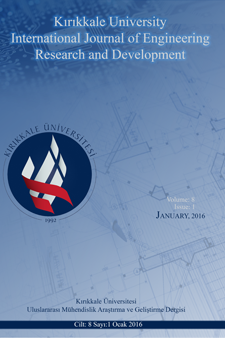Türkiye’de İş Kazalarından Kaynaklanan Ölüm ve Sürekli İş Göremezlik Vakalarının Regresyonla Tahmini
İş Kazası, Kaza Tahmin Modelleri, Regresyon Analizi, Türkiye
Prediction of Death and Permanent Incapacity Numbers Resulting From Occupational Accidents in Turkey by Using Regression Analysis
___
- Ceylan H., "Analysis of Fatal Occupational Accidents In Turkey For The Year 2013", Journal of Multidisciplinary Engineering Science and Technology, Vol. 3-2015, 2015. http://www.jmest.org/volume-3-2015 SSI., Statistical Yearbook, SSI Publication, Ankara, 1970-2012 [in Turkish]. http://www.sgk.gov.tr/wps/portal/tr/kurumsal/istatistikler - Access Date 16.05.2014. Ceylan H., "An Artificial Neural Networks Approach to Estimate Occupational Accident: A National Perspective for Turkey", Mathematical Problems in Engineering, Vol. 2014, Article ID 756326, 10 pages, 2014. Şensoy E Z., "Nonlinear Logistic Regression and Applications", Marmara University Institute of Science and Technology, Master's Thesis, pp 93, 2009, İstanbul [in Turkish]. Akgungor A P, Dogan E. "Estimating road accidents of Turkey based on regression analysis and artificial neural network approach" Advances in Transportation Studies; 2008(16): pp. 11-22, 2008. Doğan E., "Regression Analysis and Artificial Intelligence Approach for Traffic Accident Prediction Models in Turkey and selected some great Provinces", Kırıkkale University Institute of Science and Technology, Master's Thesis, 2007 [in Turkish]. Goldberg D., "The design of innovation lessons from genetic algorithms, lessons fort the real world" Techno Forecast Social Change vol 64 (1), 2000. Yigit V. "Estimation of Turkey Net Electric Energy Consumption Until to Year 2020 Using Genetic Algorithm", International Journal of Engineering Research and Development, Vol 3(2). pp.37-41, 2011. Murat Y S and Ceylan H., "Use of Artificial Neural Networks for Transport Energy Demand Modeling", Energy Policy Vol 34(17). pp 3165-3172, 2006. Chio Y.C. "An ARIMA Modeling: A Case Study of Turkey", Energy Policy, Vol 35, No 2, pp 1129-1146, 2007. Chiou Y.C. "An artificial network-based expert system for appraisal of two-car crash accidents", Accident Analysis and Prevention Vol.38, No.4, pp.777-785, 2006. Akgüngör, A P, Doğan E, "An artificial intelligent approach to traffic accident estimation; Model development and application" Transport, Vol.24 No,2 pp.135-142, 2009. Akgüngör A. P. ve Doğan E., "Traffic Accident Prediction Models Developed Using Different Methods and Analysis"; Int. J. Eng. Research & Development, Vol.2, No.1 January 2010 [in Turkish]. Önal S, "Forecasting of Flow of Kızılırmak River By Using Neural Networks Method", Süleyman Demirel University Institute of Science and Technology, Master's Thesis, pp 129, 2009, Isparta [in Turkish]. Comaniciu D. and Meer P., "Mean Shift Analysis and Applications", IEEE International Conference on Computer Vision, pp. 1197--1203, 1999. Şen, Z, Artificial Neural Networks, Water Foundation Publications, İstanbul pp 183, 2004, [in Turkish]. Mussone L, Ferrari A, Oneta, M. "An analysis of urban collision using an artificial intelligence model" Accident Analysis and Prevention, Vol.3, No.8, pp.705-718, 1999. Abdelwahab H T, Abdel-Aty M A. "Development of artificial neural network models to predict driver injury severity in traffic accident at signalized intersection" Transportation Research Record 1746, pp.6-13, 2001 Delen D, Sharda R, Besson M. "Identifying significant predictors of injury severity in traffic accidents using a series of artificial neural networks" Accident Analysis and Prevention Vol.38, No.3, pp.434-444, 2006. Doğan E. ve Akgüngör A.P., "Investigation of traffic accidents and results with artificial neural networks: Kırıkkale Case" The 8. Transportation Congress, pp. 279-287, September/October 2009 İstanbul. A. P. Akgüngör and E. Dogan, "Artificial Neural Networks and Genetic Algorithm Approach to Accident Prediction Models Own Istanbul Metropolis",Modern Methods in Science Symposium, pp. 883- 891, 15-17 October 2008, Eskişehir.
- Yayın Aralığı: 2
- Başlangıç: 2009
- Yayıncı: -
Elektrikli Araçlar İçin Fırçasız Doğru Akım Motorlarında Değiştirilebilir Manyetik Alan Uygulaması
Hasan TİRYAKİ, Alper Sefa ÇAĞIŞLAR, Abdurrahim AKGÜNDOĞDU, İlhan KOCAARSLAN
Değiştirilmiş Hata Türü ve Etkileri Analizi Yöntemi ile Tedarikçi Seçimi Uygulaması
CRISPR-Cas İmmün Sisteminin Biyolojisi, Mekanizması ve Kullanım Alanları
Zehra GÜN GÖK, Beste ÇAĞDAŞ TUNALI
Türkiye’de İş Kazalarından Kaynaklanan Ölüm ve Sürekli İş Göremezlik Vakalarının Regresyonla Tahmini
Genetik Algoritmayla Bindirmeli Tip Kaynaklı Bağlantılarda Optimum Kaynak Kalınlığı Seçimi
